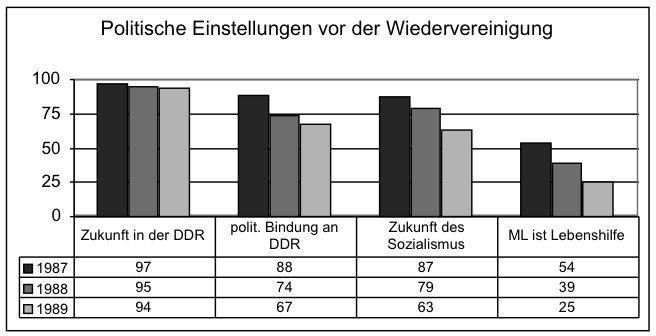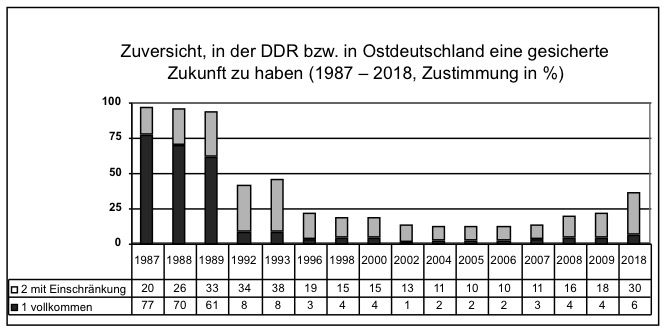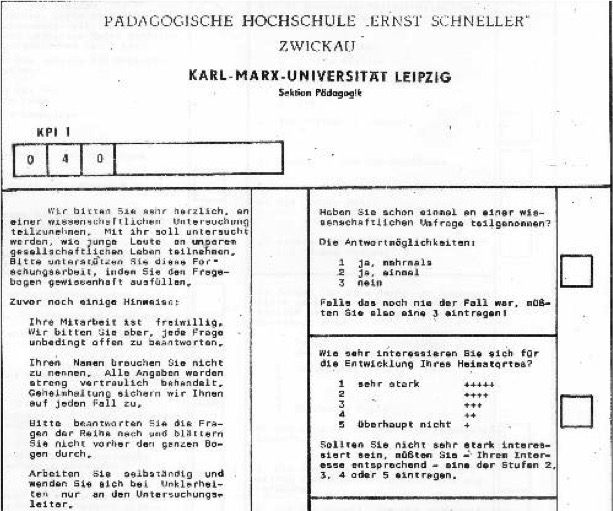The study was conducted from 1987 (wave 1) to 1989 (wave 3) by the Central Institute for Youth Research (Zentralinstitut für Jugendforschung) in Leipzig. It was one of many studies that the institute carried out on the GDR adolescents. The questions back then were tailored to the specific needs of the time. For example, a lot was asked about their activity with the Free German Youth (FDJ – Freie Deutsche Jugend). The participants were in the 8th grade of the Polytechnic High School during the first survey wave and were approximately 14 years old.
The cover of the page shows the first questionnaire of the 1987 study. Even then, the voluntary participation of the study was emphasized: „Your cooperation is voluntary“. One student recalled in 2019: „I remember I was in the 8th grade of the Pablo Neruda School in Leipzig when one day a man stood in front of our class and said that we should all take part in a survey. I did not know who he was. But he was probably from the Central Institute for Youth Research. Some classmates were unwilling to join in.“
For a while you could read online “It just came upon us. It means we “had” to take part in the study under the supervision of our eagle-eyed former class teacher. But all in all, we all enjoyed it (instead of cramming Russian, we just had to answer the survey questions). I do not know anymore what was asked at the time. However, I can find out if others still know, because I am still in touch with most of my old classmates today. We also had a spontaneous class meeting, which is why I know that many of them are still participating.” (cited by Berth et al., 2012, p. 16).

The figure shows from the first three survey waves the agreeing answers to the questions/ statements:
- I have a safe future in the GDR.
- I feel strongly attached to GDR as my socialist fatherland.
- Future belongs to socialism. Regardless of the temporary setbacks.
- The Marxism-Leninism helps me to find the right answer for all the important questions of life.
In all four thematic areas queried, there was an outstanding decrease in the positive responses from Wave 1 (1989) to Wave 3 (1989). The data shows how young people are evaluating their home GDR more and more, and their dissatisfaction is growing. The increase in willingness to criticize is also linked to the development of young people from their 14th (1987) to their 16th birthday (1989). They develop their own political opinion and are prepared to express themselves critically. The statement on having a secure future in the GDR had always the highest rate on agreement. With 94 to 97% agreement rate over the three years, almost everyone is certain that their future is secure.

Along with the German reunification the trust in safe future in East Germany collapsed from there on. Only a few were convinced about it, in the years 2005 and 2006 only 12%. After that optimism about the future started rising again. In the latest enquiry the rate was 36%. That is also not exactly in the level of 1992 and very far away from the 90% of the time before reunification.
After the 3rd wave in early 1989 the study was planned to be completed. Rather by chance, the participants were asked if they would be willing to participate in the future. 587 people responded positively and they still form the study population of Saxon Longitudinal Study today (more: History).
References:
Förster, P. (2002). Junge Ostdeutsche auf der Suche nach der Freiheit. Eine systemübergreifende Längsschnittstudie zum politischen Mentalitätswandel vor und nach der Wende. Opladen: Leske + Budrich.
Berth, H., Förster, P., Brähler, E. & Stöbel-Richter, Y. (2007). Einheitslust und Einheitsfrust. Junge Ostdeutsche auf dem Weg vom DDR- zum Bundesbürger. Eine sozialwissenschaftliche Längsschnittstudie von 1987-2006. Gießen: Psychosozial-Verlag.
Berth, H., Brähler, E., Zenger, M. & Stöbel-Richter, Y (2012). Die Sächsische Längsschnittstudie – Informationen zu einer aussergewöhnlichen Untersuchung. In H. Berth, E. Brähler, M. Zenger & Y. Stöbel-Richter (Hrsg.), Innenansichten der Transformation. 25 Jahre Sächsische Längsschnittstudie (1987 bis 2012) (S. 15-28). Gießen: Psychosozial-Verlag.

